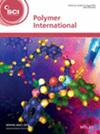求助PDF
{"title":"Crosslinking effects on high-oleic soybean oil-based anionic polyurethane dispersions","authors":"Jasna Djonlagić, Zoran Petrović, Jian Hong, Milica Lovrić Vuković","doi":"10.1002/pi.6752","DOIUrl":null,"url":null,"abstract":"<p>Waterborne polyurethane dispersions are known as non-toxic, non-flammable, environmentally friendly products widely used in the coatings industry. We prepared a series of anionic dispersions based on the polyol from high-oleic soybean oil, isophorone diisocyanate and dimethylol propionic acid. Stable anionic dispersions were achieved when the acid content in formulations ranged from 7.7 to 10.8 wt%. All dispersions in this series had average particle sizes of 163–211 nm with unimodal size distribution. Utilization of the high-oleic oil, with three double bonds on average, and the resulting trifunctional polyol, renders crosslinked products with improved hydrophobicity and excellent chemical and physical properties. Also, it is beneficial in the control of the synthesis process since it reduces the chance of gelation during the dispersion preparation, compared to natural oils with higher unsaturation. The network formation in the systems used was analyzed by applying gelation theory to adjust optimal time for the dispersion in water. It was found that the isocyanate reaction with water always produces imperfect networks but the degree of imperfection can be controlled by the reaction time before dispersion in water. The polyurethane formulations with hard segment content of 39–46 wt% resulted in cured elastomeric films, with single glass transitions around room temperature and low phase separation, but good mechanical properties. The films exhibited enhanced hydrophobicity, low water absorption and water contact angle close to 90°, with promising applications in leather, wood, paper and plastic coatings. © 2025 Society of Chemical Industry.</p>","PeriodicalId":20404,"journal":{"name":"Polymer International","volume":"74 7","pages":"593-601"},"PeriodicalIF":3.6000,"publicationDate":"2025-02-13","publicationTypes":"Journal Article","fieldsOfStudy":null,"isOpenAccess":false,"openAccessPdf":"","citationCount":"0","resultStr":null,"platform":"Semanticscholar","paperid":null,"PeriodicalName":"Polymer International","FirstCategoryId":"92","ListUrlMain":"https://scijournals.onlinelibrary.wiley.com/doi/10.1002/pi.6752","RegionNum":4,"RegionCategory":"化学","ArticlePicture":[],"TitleCN":null,"AbstractTextCN":null,"PMCID":null,"EPubDate":"","PubModel":"","JCR":"Q2","JCRName":"POLYMER SCIENCE","Score":null,"Total":0}
引用次数: 0
引用
批量引用
Abstract
Waterborne polyurethane dispersions are known as non-toxic, non-flammable, environmentally friendly products widely used in the coatings industry. We prepared a series of anionic dispersions based on the polyol from high-oleic soybean oil, isophorone diisocyanate and dimethylol propionic acid. Stable anionic dispersions were achieved when the acid content in formulations ranged from 7.7 to 10.8 wt%. All dispersions in this series had average particle sizes of 163–211 nm with unimodal size distribution. Utilization of the high-oleic oil, with three double bonds on average, and the resulting trifunctional polyol, renders crosslinked products with improved hydrophobicity and excellent chemical and physical properties. Also, it is beneficial in the control of the synthesis process since it reduces the chance of gelation during the dispersion preparation, compared to natural oils with higher unsaturation. The network formation in the systems used was analyzed by applying gelation theory to adjust optimal time for the dispersion in water. It was found that the isocyanate reaction with water always produces imperfect networks but the degree of imperfection can be controlled by the reaction time before dispersion in water. The polyurethane formulations with hard segment content of 39–46 wt% resulted in cured elastomeric films, with single glass transitions around room temperature and low phase separation, but good mechanical properties. The films exhibited enhanced hydrophobicity, low water absorption and water contact angle close to 90°, with promising applications in leather, wood, paper and plastic coatings. © 2025 Society of Chemical Industry.
高油基大豆油阴离子聚氨酯分散体的交联效应
水性聚氨酯分散体是一种无毒、不易燃、环保的产品,广泛应用于涂料行业。以高含油大豆油、异佛尔酮二异氰酸酯和二甲基丙酸为原料制备了一系列阴离子分散体。当配方中的酸含量在7.7 ~ 10.8 wt%范围内时,阴离子得到了稳定的分散。该系列分散体的平均粒径为163 ~ 211 nm,呈单峰型分布。利用平均有3个双键的高含油量油和得到的三功能多元醇,使交联产物具有更好的疏水性和优异的化学物理性能。此外,与具有较高不饱和度的天然油相比,它有助于控制合成过程,因为它减少了分散制备过程中凝胶化的机会。应用凝胶理论对系统的网络形成进行了分析,调整了系统在水中分散的最佳时间。研究发现,异氰酸酯与水的反应总是产生不完美的网络,但不完美的程度可以通过反应时间来控制。硬段含量为39-46 wt%的聚氨酯配方可获得固化的弹性体膜,在室温下具有单玻璃化转变,相分离率低,但力学性能良好。该膜具有疏水性增强、吸水率低、水接触角接近90°的特点,在皮革、木材、纸张和塑料涂料中具有广阔的应用前景。©2025化学工业协会。
本文章由计算机程序翻译,如有差异,请以英文原文为准。



 求助内容:
求助内容: 应助结果提醒方式:
应助结果提醒方式:


